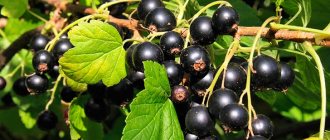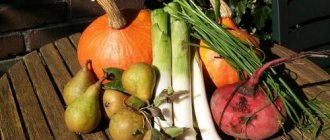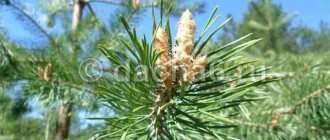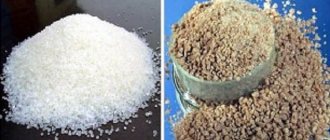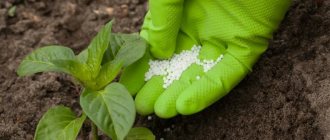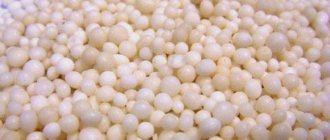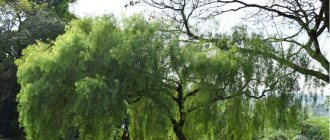What is sapropel?
Proceeding from the contrary and bearing in mind that the substance is used as a fertilizer, sapropel should be considered from this point of view. Sapropel deposits are found at the bottom of fresh lakes, reservoirs, and quarries.
Outwardly, they look and smell quite repulsive. The black mass, reminiscent of dirt, exudes the smell of rotted organic matter. Industrial development of deposits is undertaken only when the layer thickness reaches 7 meters or more.
In many cases this figure is 30 and 40 meters. Obviously, the accumulation of such a layer takes a very long time: plant and animal remains sink to the bottom, where they are processed by bacteria that live without oxygen - anaerobes.
Unlike sludge, sapropel is rich in useful substances; it has a layered structure reminiscent of jelly or soft oil.
Proper processing turns lake sediments into a useful fertilizer, which has long been widely used and loved by advanced gardeners. It replaces chemicals and provides complete natural fertilizers for plants.
Rules for adding sapropel to the soil
Sapropel granules as a natural biostimulant can be added to the soil both in late autumn, during deep digging, and in early spring. The only difference is that in the fall the granules are scattered into planting holes or on the surface of the ground in dry form. In spring, the fertilizer is dissolved in water and the diluted concentrate is added to the already planted plants.
Fertilizer application rates for digging
A conscientious manufacturer, guaranteeing an excellent and expected result, will definitely indicate the fertilizer consumption rates, both in dry and in liquid, diluted form for various gardening operations.
In particular, when digging up vegetable beds, sapropel is generously sprinkled on the surface of the earth at the rate of 1-2 kg of dry matter per 1 square meter of area. Next, the beds are dug up. Thus, the nutrient granules move deeper, where they begin their “business of refining” the soil depleted over the summer.
How to fertilize a berry bush with sapropel
If you need to fertilize the soil in a hole with sapropel before planting a berry bush, then it is enough to add a couple of handfuls of natural dry fertilizer. The sapropel in the hole is mixed with soil, spilled and the prepared seedling is planted. The sprout is sprinkled with mixed soil, the soil mixture is compacted and watered.
If it is necessary to fertilize an already growing and fruiting strawberry bush with sapropel, then a couple of handfuls of fertilizer are poured under the root of the plant, and by slightly loosening, the natural nutrition is slightly deepened. The plant is watered and the soil is mulched to prevent rapid drying. The granules dissolve only due to the presence of moisture.
Useful properties of sapropel
Due to its composition, sapropel is a natural storehouse of minerals. In a form accessible to plants, it contains potassium, sodium, phosphorus, amino acids, vitamins (B, E, C, P, D), organic enzymes, and humic acids. Due to its chemical composition, sapropel is used to feed plants:
- humic acids included in its composition act as a bactericidal agent, destroying pathogenic bacteria;
- heavy soils (clayey, loamy) acquire a looser structure, facilitating root aeration and better plant growth;
- thanks to the application of sapropel, soil productivity does not decrease over the next 4-5 years, which makes it possible to do without fertilizers;
- thanks to fertilizing, the soil itself forms a new fertile layer;
- the soil, due to the unique structure of sapropel, retains moisture better, which allows you to water less frequently and not worry about the plants during the dry period;
- bacteria living in sapropel process the soil and increase the amount of humus in it.
Thanks to such fertilizing, crop yields increase, which is the original goal. In flower beds and alpine hills, adding sapropel prolongs flowering and stimulates flower growth.
Common mistakes when using sapropel
Many gardeners cannot fully appreciate all the positive qualities of this product due to improper use of sapropel.
Typical mistakes of summer residents:
- Many people use sapropel alone, not taking into account that it does not contain all the elements necessary for the life support of plants (for example, it is low in phosphorus). Therefore, its presence in the soil does not give excellent results. It is better to use the substance in combination with other mineral fertilizers, in combination with which it is more effective.
- A common mistake gardeners make is to feed the soil with sapropel when digging up the site each year. It is enough to add the substrate once every few years.
- To feed each crop, certain proportions must be used. After all, what, for example, is good for a tomato is bad for an apple tree.
Characteristics of sapropel
Sapropel is sold in solid form (granules, powder), liquid or paste. Depending on the characteristics and purpose, the additive is divided into several types:
- Universal grade A is intended for use on all types of soil.
- Grade B is intended for acidic soils in order to neutralize them or reduce acidity.
- Grade B is produced for slightly alkaline and neutral soils, if they need to be slightly acidified.
Depending on the conditions under which the deposits were formed, their chemical composition changes. In addition, the extraction method and the depth at which the work was carried out (as well as the thickness of the layer as a whole) are of great importance.
Lake sapropel is:
- purely organic, the poorest, the content of organic substances does not exceed 30%, color – black;
- organic with the addition of minerals – a little richer, content of useful organic substances up to 50%, color – black;
- organic mineralized - the content of useful substances is above 50%, but below 80%, color - grayish-black;
- mineralized – the content of useful substances exceeds 80%, color – gray.
Depending on what substances predominate in the composition, sapropel is divided into carbonate, ferrous, organic, and siliceous.
Can it be used?
Bottom fertilizer cannot cause any harm to garden crops, so it can be safely used, especially on depleted and problematic soils. Gardeners like to add it directly to the soil when planting.
Benefit
- Eco-friendly.
- Improves the structure of any soil.
- Increases the productivity of beds.
- Excellent water retention.
- Fights fungus and harmful bacteria.
- Stimulates the growth and development of the plant root system.
Sapropel applied to the soil continues to act for 7 years.
Advantages
- Perfectly sanitizes the soil, clearing it of pathogenic microflora.
- Increases the percentage of organic matter in the soil.
- Promotes rapid growth of garden crops.
- There are no contraindications for use.
- It is permissible to apply throughout the gardening season.
How to recognize real high-quality sapropel
Of all the available types of sapropel, organo-mineral and organic are considered the most useful for use in a summer cottage. They are distinguished by their rich dark color and crumbly structure. It is this product that is then processed.
Sapropel is extracted on an industrial scale using special equipment - dredgers. Since the work is carried out at depth, sapropel is raised to the surface.
After this, it is sifted until a grayish-black homogeneous substance is obtained. They continue to work with it: they transform it into a state suitable for use.
In the garden you can use liquid and paste sapropel. But it is much more convenient and practical to use fertilizer in solid (tablet or granular) form. To obtain it, sapropel is dried or frozen.
Extraction of sapropel mechanically and manually
On an industrial scale, sapropel is extracted using special machines called dredgers. They are capable of removing large amounts of humus from fresh water bodies due to powerful engines and a special structure.
To obtain smaller volumes, special garden equipment is used, which in shape and design resembles a conventional generator. It comes in various modifications, weighs from 15 to 250 kilograms and has a capacity of up to 30-35 cubic meters. at one o'clock. Due to its small dimensions, it is easy to transport using a car trailer or in the bodies of minibuses and gazelle-type trucks.
The cost of high-quality dry sapropel starts at 2000-2500 rubles per ton. The fresh version is cheaper and is purchased from specialized farms or fisheries. When using a mechanical mini-projectile, you can easily pump out up to 300 kg of the necessary fertilizer per day. Bottom mass is obtained only from the bottom of stagnant, stagnant lakes.
In some regions, on the marshy shallows of fresh lakes, gardeners extract sapropel by hand. To do this, use ordinary garden forks, convert them with flexible wire with a cross-section of at least 0.3 mm, which is intertwined over iron rods. The resulting device is used to dig out the required amount of organic fertilizer.
Sapropel, rich in vitamins and microelements, is found throughout the country, but the best are those obtained from clean reservoirs with the most developed flora and fauna. In this case, environmentally friendly material is lifted from the bottom, without harmful chemical impurities and deposits such as fuel oil and other heavy compounds.
How to extract sapropel yourself
But if there is a suitable lake not far from a private farmstead and garden, and there is sapropel in the lake, how can you get it yourself?
Option one, semi-professional
Purchase equipment whose operating principle resembles professional equipment, but is intended for private use. Miniature dredgers are mobile. They are transported in vans or forklifts. They weigh about 200 kg and are easy to use.
In an hour of work you can extract up to 30 cubes of sapropel;
Option two, amateur
To obtain useful enriched sludge, ordinary garden forks are turned into a mesh with a fairly fine mesh size using wire.
If sapropel lies close to the shore, on the shallows, then using a modernized fork, like a net, it is raised to the surface. Productivity is lower, but without special equipment, this option becomes a good alternative.
What do they do with the loot?
The extracted material is not ready for use: it must be brought to the required condition. To do this, first carefully sift the mass through a large sieve, removing large particles, debris, and stones. What is sifted must be spread out in a thin layer and dried to remove moisture.
The humus is turned over, poured and dried until the mud-like paste turns into a dark, dry, free-flowing powder. Otherwise, the process of rotting will begin, as evidenced by a sharp ammonia smell. Along with it, the nitrogen needed by plants will go into the air.
Do-it-yourself organic fertilizer extraction
You can produce fertilizer yourself. Sapropel can occur at shallow depths. In shallow wetlands, it is dug out using wire forks. To do this, make a wire mesh on the forks.
Its diameter must be at least 0.2 mm. Fertilizer is also extracted using special equipment.
Extract the substance from an environmentally friendly area. It is known that sapropel is able to absorb heavy metals and other harmful components.
The resulting humus must be drained. Pass it in small portions through a special sieve to sift out the broken stone. The fraction needs to be dried and the dirt turned into dry powder. Otherwise, the organic matter begins to rot and loses its beneficial properties.
Extracting the material yourself will save you money tenfold.
Composition of sapropel
You need to understand that sapropel mined in different places differs from each other. The general name brings together fertilizers obtained from material raised from the bottom of a freshwater lake. In it, under the influence of anaerobic bacteria (without oxygen), organic residues were processed for a very long time, layering on top of each other.
The composition of sediments depends on:
- flora and fauna of a particular lake,
- mineral components,
- intensity of the process,
- age of sediments,
- the depths of their production.
Depending on what substances are part of the sediment, sapropel can be black, gray, light and even pinkish.
Reviews from gardeners about the use of sapropel
Sapropel is not as well known as other organic fertilizers. Many gardeners have undeservedly forgotten about it, or it is simply rarely found on sale. However, those who are lucky enough to find high-quality fertilizer grow crops that are the envy of everyone they know.
Omsk resident Maria Agapkina: “Sapropel saved my roses. The flowers fell ill with an unknown illness; not a single purchased product helped. I diluted sapropel tar (100 ml in a bucket of water) and watered the bushes from a watering can. Covered with film. In the spring I processed it again and applied fertilizer to the bush. The roses bloomed beautifully all season! I also add fertilizer to the tomatoes. I have never seen such harvests in my entire life. Large, beautiful, I don’t have time to take pictures. I process the potatoes before planting, I forgot about the beetles.”
Tyumen resident Galina: “I accidentally saw sapropel on a store shelf. Ours, real, Tyumen! I feed flowers and seedlings at the dacha. Diseases and pests are avoided. The plants are strong and beautiful.”
Sapropel is a unique organic fertilizer that is extracted from the bottom of lakes. The rich composition helps restore the fertility of even the poorest soils. It is suitable for fertilizing all garden crops.
Varieties of sapropel
Lake sapropel, the use of which in the form of fertilizer is mainly of interest to summer residents and people busy with their gardens, is assessed from the point of view of the presence, absence and value of three components: organic matter, minerals and biologically active components.
Sapropels, which have a rich dark (black) color, have a low ash content (up to 30%), so they are most in demand in agriculture.
Organic
As a rule, these are the remains of plants living on the surface, in the water column and at depth, zooplankton, benthos (at various stages of decomposition and processing).
Biologically active components
The products of their vital activity act as a biologically active component:
- humic acids,
- enzymes,
- amino acids,
- proteins,
- vitamins,
- alcohols,
- phytopigments,
- antibiotics.
Mineral component
These are compounds of calcium and silicon, as well as copper, molybdenum, cobalt, manganese, boron, bromine, iodine, vanadium, nickel and others.
Depending on the component that predominates in the chemical composition
Depending on the predominant component, sapropels are divided into:
- carbonate;
- glandular;
- calcareous (calcium oxide content from 30%);
- siliceous (silica content exceeds 50%);
- organic (ash content below 30%);
- mixed.
Depending on ash content
If we evaluate the ash content, the classification is as follows:
- low ash - with ash content up to 30%;
- medium ash - with an ash content of 30-50%;
- high ash content up to 70%;
- high-ash - with an ash content of 70-85%;
- sludge - with ash content over 85%.
Mechanism of action
The natural ooze comes in a variety of forms. It can be a powdery mass or liquid. And also paste-like, granular. Organic components and valuable substances are preserved in all specified forms.
In the form of granules and powder, sapropel is directly a fertilizer. Paste and liquid - as a medicinal form for people or for large plots of land during the reclamation period.
At its core, the substance is silt, which has been dried in a special way. Fossil is an inexhaustible source of vitamins, enzymes and minerals. The beneficial effects of microelements ensure high productivity of fruit and berry crops.
Areas of application
There are several ways to use sapropel. In medicine and cosmetology, the beneficial organic sediment is used to combat excess weight and cellulite (in the form of wraps and compresses).
Even in the last century, sapropel served as a source of technical oils; theoretically, motor fuel, acids and methyl alcohol, construction materials and biogas can be obtained from it.
Properly processed sapropel has found application in pharmacology; biologically active additives for animal feed are made from it, but mainly used as fertilizer.
The use of sapropel in gardening
It is no coincidence that sapropel is called the best fertilizer that can be used in a summer cottage. The use of organic sediments is especially important in garden plots with heavy clay or loamy soil, poor in nutrients, difficult to drain and aerate. In such conditions, garden trees need constant digging and loosening of tree trunks, frequent watering and the addition of drainage materials to the soil.
Sapropel easily takes on this role. The soil is dug up to a depth of 10-12 cm, after which sapropel is added. When rooting young seedlings or transplanting fruit and berry bushes to a new location, sapropel is placed directly into the hole, mixed with soil in a ratio of 1:4.
Its presence makes the soil looser, lighter, promotes air penetration to the roots, retains moisture in the root zone, and releases minerals into the soil that trees need. Sapropel is added not annually, but once every 3-5 years.
Also, dry sapropel is poured into tree trunk circles without covering them, having first loosened and moistened the soil well.
It is possible to increase the productivity of bushes and trees by introducing a manure-sapropel mixture, which combines the properties of a soil loosening agent and organic fertilizer.
Use in the garden
Sapropel has found the widest application in vegetable gardens. First of all, it is used to improve the structure of the soil.
Heavy clay soils and loams require a lot of work so that the plants not only feel at ease, but also produce a rich harvest. They add materials that improve soil properties, drain, aerate: sand, peat, compost.
Sapropel is often used as one of the elements of a complex soil mixture.
When growing melons, you need not only sunlight, but also the right soil. To create it, six parts of soil and four parts of sand are added to three parts of sapropel.
For cabbage, lettuce, and other leafy crops, the growing mixture is prepared from three parts of sapropel, two parts of garden soil and four parts of sand.
To plant seedlings in open ground, flowers or small-seeded crops (for example, beets, carrots), you need to add 3 kg of sapropel per m2 and thoroughly dig up the area, and then plant the plants.
When planting potatoes on an industrial scale, 120 tons of sapropel per 1 hectare are applied to plots.
A good result is obtained by combining sapropel with organic fertilizers (for example, mullein, manure, bird droppings, humus).
Is it worth observing the measure? Instructions for use
It is impossible to overdose on sapropel. There cannot be too much useful and natural nutrition for a developing plant, even if the dosage recommended by the manufacturer is violated during application. Fertilizer does not dissolve quickly. For quite a long time, the planted crop will not need feeding - the granules will replenish the missing nutrition. And excess bioconcentrate particles in the soil will not cause harm to roots, fruits and above-ground parts, due to their natural origin.
The roots of the plant can quite freely come into contact with sapropel granules throughout the entire growth period. And there is no need to worry about the root system drying out. It is impossible to burn the roots of both young and adult plants with an overdose of sapropel. Simultaneous application of a large amount of sapropel into the planting hole will provide the plant, tree or shrub with the necessary nutrition for 5 years.
Therefore, if the drug is financially available, you can safely apply it to the soil on the site in unlimited quantities.
Purchase in store
Ready-made fertilizers, widely available in specialized stores, vary by brand. The latter determine the purpose of use in the garden.
A-grade is a universal fertilizer that can be used on all types of soil.
B-grade is organic, intended for lands with a high level of acidity.
B-grade – used for neutral or slightly alkaline soil types.
Sapropel is sold both wholesale and retail.
For wholesale distribution, fertilizer is packaged in special bags or standard containers. And only then each intermediary is involved in packaging the raw materials for sale in retail chains. The main thing is to ensure complete safety of useful components.
Pricing depends on several factors. If you purchase raw materials in the spring from large fish farms that periodically clean reservoirs, then their cost will be small - up to 1,500 rubles per ton. Fertilizer in powder form will cost twice as much.
Most often found in retail:
- Friable sapropel in bags (from 60 rubles per 1 kg).
- Granulated in buckets (from 190 rubles for 5 l).
- Liquid fertilizer for certain types of plants: vegetables, roses, orchids (from 77 rubles per 0.5 l).
In addition, bottom fertilizer is sold as part of complex mixtures for seedlings. Its cost is from 50 rubles. for 5 l.

